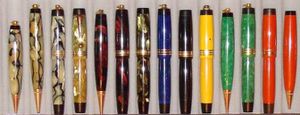Differenze tra le versioni di "Parker/en"
(Creata pagina con 'The success of the Duofold, despite its price (10 dollars) was high for the time, continued for over a decade in which the models were revised several times, adjusting the...') |
|||
| Riga 26: | Riga 26: | ||
[[Parker]] continued to produce ebonite pens with good results, focusing on the functionality of his pens and on the benefits of the [[button filler]], but the real breakthrough came in 1921 with the launch of [[Duofold]], which was a huge success, by getting the company at the top of sales. The creation of a large pen, made of hard rubber of a bright red color, was a revolution in the foutain pen world until then dominated by the black color, and foreshadowed the introduction of the celluloid colors by several years. | [[Parker]] continued to produce ebonite pens with good results, focusing on the functionality of his pens and on the benefits of the [[button filler]], but the real breakthrough came in 1921 with the launch of [[Duofold]], which was a huge success, by getting the company at the top of sales. The creation of a large pen, made of hard rubber of a bright red color, was a revolution in the foutain pen world until then dominated by the black color, and foreshadowed the introduction of the celluloid colors by several years. | ||
| − | The success of the [[Duofold]], despite its price (10 dollars) was high for the time, continued for over a decade in which the models were revised several times, adjusting the production to the introduction of new materials such as celluloid or the new ''[[Streamlined]]'' style with tapered models. In 1923 was opened a plant in Canada, and was introduced a | + | The success of the [[Duofold]], despite its price (10 dollars) was high for the time, continued for over a decade in which the models were revised several times, adjusting the production to the introduction of new materials such as celluloid or the new ''[[Streamlined]]'' style with tapered models. In 1923 was opened a plant in Canada, and was introduced a [[Duofold|Lady Duofold]] model for women. In 1926 also the [[Parker]] began to move production from ebonite to celluloid. |
[[Image:Parker-Duofold-VestsPocket-Serie.jpg|thumb|All color for ''[[Vest pocket]]'' [[Duofold]].]] | [[Image:Parker-Duofold-VestsPocket-Serie.jpg|thumb|All color for ''[[Vest pocket]]'' [[Duofold]].]] | ||
Versione delle 16:54, 1 gen 2012
Parker is one of the few American historical fountain pens brand remained continuously active to this day. The Parker Pen Company was founded by George Safford Parker in 1889 in Janesville, Wisconsin. Today the company is owned by Sanford, a division of Newell Rubbermaid that also owns Waterman.
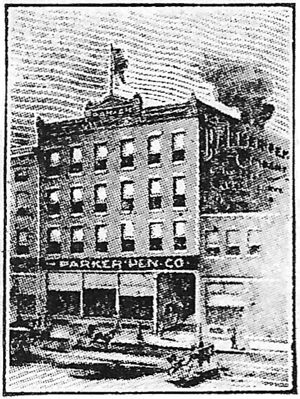
Although the company always produced good quality fountain pens, Parker golden age goes from the '20s to '60s, when the company has distinguished itself for its great innovation capacity, obtaining always strong success. Thanks also to the creation of a vast network of branch offices (Canada, England, Denmark, France, Mexico, and Argentina), the company always maintained top rankings in worldwide sales of fountain pens, and was successful also in the ballpoint pen era. Together with Sheaffer, Waterman and Wahl-Eversharp is a recognized member of the Big Four.
History
Parker was foundend in Janesville in Wisconsin in 1889 by George Safford Parker, which previously had operated as a reseller for the John Holland Pen Company. George Parker, who worked as a teacher of telegraphy, supplemented its income with the trade in fountian pens. Having to repair the pens that he sold, it began to improve their functioning, and because the pens he changed worked better than the original and had success, he decided to found his own company.

He obtained his first patent (nº US-293545) in 1889, and a subsequent patent (nº US-512319) in 1894 for his special Lucky Curve feeder, which went back inside the pen with a special curved shape that is claimed to be able to call back the excess ink when the pen was not in use. In 1891 George Parker associated with W. F. Palmer, an insurer and they incorporated The Parker Pen Company in Janesville.
In fact, the "Lucky Curve" was simply a good feeder, which remained in production until 1928, and was used as a trademark for a number of pens, but there are doubts that the curved form actually had the effect to avoid the accumulation of ink, because much repairers cutted it, because the curved part makes it difficult to reinsert it between the nib and section.
In the early years Parker began manufacturing good quality ebonite pens. In this period it was famous for her silver overlay pens, and in particular for the Snake pen with a snake shaped overlay, that is sought after by collectors for its rarity, and for the Black Giant pen, characterized by a very large size. Another distinction point for Parker pens was the creation of button filler, introduced in 1916 as reaction to the creation of the lever filler, which was never been used in the company's flagship models, despite is diffusion between all the competitors of that time.
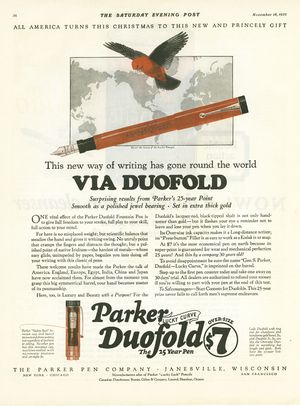
Parker continued to produce ebonite pens with good results, focusing on the functionality of his pens and on the benefits of the button filler, but the real breakthrough came in 1921 with the launch of Duofold, which was a huge success, by getting the company at the top of sales. The creation of a large pen, made of hard rubber of a bright red color, was a revolution in the foutain pen world until then dominated by the black color, and foreshadowed the introduction of the celluloid colors by several years.
The success of the Duofold, despite its price (10 dollars) was high for the time, continued for over a decade in which the models were revised several times, adjusting the production to the introduction of new materials such as celluloid or the new Streamlined style with tapered models. In 1923 was opened a plant in Canada, and was introduced a Lady Duofold model for women. In 1926 also the Parker began to move production from ebonite to celluloid.
Nel 1926 venne anche introdotto un modello economico, la Parker DQ, da Duofold Quality. Nel 1927 l'azienda introdusse i modelli Pastel in colori pastello come alternativa al modello Duofold da signora venduto ad un prezzo minore, ma con l'arrivo della grande depressione l'azienda si trovò ad affrontare un periodo critico.
Nel 1929 i profitti che fino allora erano stati enormi subirono un ripido crollo, molti produttori fallirono ed altri si ritrovarono a svendere le proprie penne. La Parker che aveva impiegato anni a stabilire il suo marchio decise di non svalutare le sue penne e mantenne i prezzi elevati per la Duofold, per rispondere alla concorrenza però nel 1932 introdusse sul mercato anche una serie di modelli economici, di tipo scolastico, per i quali non fece nessuna pubblicità. Questi modelli non ebbero assegnato un nome e vengono usualmente indicati dai collezionisti come Thrift Time, o depression pen.
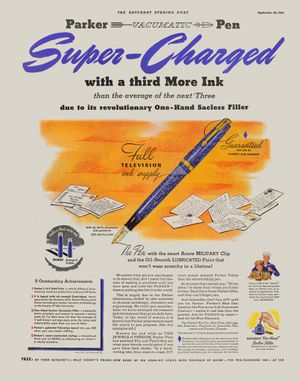
L'azienda comunque, avendo saggiamente accumulato riserve nel periodo di boom, non smise mai di investire in ricerca, sperimentando nuovi materiali e nuovi sistemi di caricamento, fino ad arrivare alla realizzazione, nel 1933, della splendida Vacumatic, con la clip a freccia disegnata dal Joseph Platt, che da allora è diventata il simbolo dell'azienda, e dotata di un serbatoio trasparente grazie al particolarissimo omomimo meccanismo di caricamento, che riportò l'azienda ai vertici del mercato.
Nel 1939 (o nel 1940), seguendo una tendenza inaugurata dalla Sheaffer con il suo White dot e seguita poi da altre marche, anche la Parker adottò un simbolo per indicare la garanzia a vita, ponendo in testa alla clip delle proprie penne il Blue diamond, un piccolo rombo smaltato in blu. A differenza di quanto accaduto per le altre marche il simbolo fu introdotto in ritardo ed ebbe vita relativamente breve, andando a sparire dopo alcuni anni.
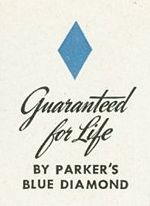
Nonostante i grandi successi ottenuti e la buona qualità tecnica delle sue penne, la Parker continuò ad investire molto in ricerca ed innovazione, e nel 1941 introdusse un modello rivoluzionario, la 51, prima stilografica realizzata in resina plastica (chiamata Lucite), con il caratteristico pennino coperto, necessario per l'uso di un nuovo inchiostro ad essiccamento rapido (il Superchrome Ink) che tendeva a degradare la celluloide. La penna, benché a posteriori non possa essere considerata particolarmente bella, e nonostante fosse costruita in ordinario materiale plastico, ebbe un successo straordinario, e costituisce il modello di stilografica più venduto di tutti i tempi.
La 51 conobbe negli anni successivi una serie di modifiche, come il passaggio nel 1948 al sistema di caricamento denominato aerometric, alla realizzazione di diverse versioni, comprese alcune di lusso in metalli preziosi, o con particolari lavorazioni del cappuccio metallico. Alcune di queste sono estremamente rare e molto ricercate dai collezionisti.
Negli anni seguenti la Parker proseguì con l'introduzione di nuovi modelli e nuove tecnologie, con il particolarissimo caricamento a capillarità della 61, o la realizzazione della T1 in titanio, rimanendo nel mercato della penna stilografica con modelli di lusso ed economici, ed al contempo ottenendo grandi successi anche nella produzione delle nuove penne a sfera.
La Parker è rimasta sempre attiva sul mercato delle penne, anche se a partire dal 1976 l'azienda otteneva più profitti dell'agenzia di lavoro temporaneo Manpower che dalla vendita di penne. Nel 1993 l'azienda venne acquisita dalla Gillette Company, che già possedeva la PaperMate. Nel 2000 la Gillette cedette la divisione strumenti di scrittura alla Newell Rubbermaid, che già possedeva la Waterman.
Template:CronoMarche |- | 1889 || Nascita della Parker |- | 1891 || La Parker diventa società di capitali con il nome di The Parker Pen Company |- | 1894 || Ottenuto il brevetto per l'alimentatore Lucky Curve (nº US-512319) |- | 1898 || Brevettato il cappuccio slip-on |- | 1899 || Brevettata la Jointless Pen |- | 1900 || Introdotte le Lucky Curve con rivestimento gold filigree |- | 1904 || Introdotto un primo caricamento a compressione di un sacchetto di gomma |- | 1905 || Viene brevettato l'alimentatore spear-head |- | 1907 || Creati i modelli Snake in argento ed oro |- | 1911 || Brevettato un alimentatore Lucky Curve perfezionato (nº US-990288) |- | 1912 || Introdotto il modello Jack Knife (a cappuccio di sicurezza) |- | 1913 || Introdotto un anello d'oro in testa ai cappucci dei modelli da donna |- | 1913 || Introdotto il caricamento a pulsante di fondo |- | 1914 || Introdotti i modelli Black Giant e RedGiant |- | 1916 || Brevettato il fermaglio washer clip (nº US-1197224) |- | 1917 || Prodotta per conto del dipartimento della difesa la Trench Pen per i soldati al fronte |- | 1920 || Prodotta la prima matita meccanica |- | 1921 || Introdotto il modello Duofold |- | 1922 || Aggiunti i modelli Lady e Junior alla linea Duofold |- | 1926 || Introdotti i modelli in celluloide (Unbreakable) della Duofold |- | 1927 || Introdotti i modelli Pastel in caseina |- | 1928 || Introdotto il modello Three-Fifty, più comunemente noto come True Blue |- | 1930 || Introdotto il modello Duette Vest pocket |- | 1929 || Introdotti i modelli Streamlined della Duofold |- | 1929 || Viene dismesso il modello True Blue |- | 1931 || Introdotto l'inchiostro Quink |- | 1932 || Introdotta la serie Thrift Time |- | 1933 || Introdotto il modello Vacumatic e la clip a freccia |- | 1933 || Dismessa la serie Thrift Time |- | 1935 || Introdotta la linea Parkette |- | 1936 || Introdotto il modello Challenger |- | 1936 || Introdotto il modello Golden Web |- | 1937 || Introdotte le versioni Speedline della Vacumatic |- | 1937 || Introdotte le versioni Shadowave della Vacumatic |- | 1939 || Introdotto il modello Duofold Geometric (detto anche Toothbrush) |- | 1939 || Dismesse le linee Parkette e Challenger |- | 1940 || Introdotto il Blue Diamond come indice di garanzia a vita (o 1939?) |- | 1940 || Introdotto il modello Laidtone Duofold, (dette anche striped) |- | 1941 || Introdotto il modello 51 |- | 1946 || Introdotto il caricamento Red band filler sulla 51 |- | 1947 || Introdotto il modello VS, le 51 Demi e la nuova clip e dismesso il Red band filler |- | 1948 || Introdotto il modello 21, il caricamento aerometric sulla 51 e dismesse Vacumatic e Laidtone Duofold |- | 1950 || Introdotto il modello 41 |- | 1951 || Dismesso il modello 41 e la stampigliatura della data sulle 51 prodotte in USA |- | 1953 || Dismessa la stampigliatura della data sulle 51 prodotte fuori dagli USA |- | 1954 || Introdotta la penna a sfera Jotter e la stampigliatura Made in USA sul cappuccio della 51 |- | 1956 || Introdotto il modello 61 e dismesso il Superchrome Ink (e relativi riferimenti) |- | 1960 || Introdotto il modello 45 |- | 1962 || Introdotto il modello VP |- | 1963 || Introdotto il modello 75 |- | 1970 || Introdotto il modello T1 in titanio |- |}
Models
| Model | Period | Dimension/Version |
|---|---|---|
| Duofold | 1921- |
External References
- http://www.parkerpens.org
- http://www.penhero.com/PenGallery/Parker/Parker.htm
- http://en.wikipedia.org/wiki/The_Parker_Pen_Company
- http://parkercollector.com/
- http://www.vacumania.com/
- http://www.rickconner.net/penspotters/parker.html
- http://www.rickconner.net/penoply/park.0.html
- http://www.sovereign-publications.com/parkerpen.htm
- http://www.youtube.com/watch?v=T9hOhAXaFp4&feature=related
- http://www.parkerpen.com
- http://www.mkpens.co.uk/parker_duofold_profile.htm
- http://stylosparker.over-blog.com/
- http://www.atquid.com/viewArticle.php?article_id=53&title=The_Parker_Pen_Company

